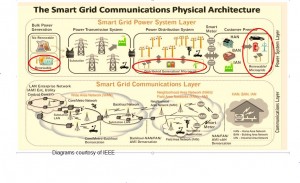The work involved understanding the type of communications that would be needed in support of effective Smart Grids and then identifying potential spectrum, on a European basis, that could meet such requirements.
Historically there was a limited number of power stations and the generated power was distributed, on demand, through the network to the end users. The main emphasis of communications then was to monitor and control the high voltage potion of the network (power transmission) but now with the advent of smart grids there are multiple sources of energy and they can be injected at multiple points in the power network as shown in the figure below. This requires a new approach to the communications that are required. From smart meters to SCADA (supervisory, control and data acquisition) to video surveillance.The focus of the study was on identifying the spectrum needed to monitor and control these emerging grid networks

These grid network applications have specific requirements in terms of propagation distances, required latency, band width etc. and potential frequency bands were prioritised in terms of applicability and likely timescales for availability.
The study findings were presented to the members of the EUTC and a discussion was held with the European Commission.
